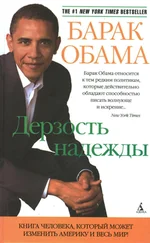Барак Обама - The Audacity of Hope
Здесь есть возможность читать онлайн «Барак Обама - The Audacity of Hope» весь текст электронной книги совершенно бесплатно (целиком полную версию без сокращений). В некоторых случаях можно слушать аудио, скачать через торрент в формате fb2 и присутствует краткое содержание. Жанр: Политика, на английском языке. Описание произведения, (предисловие) а так же отзывы посетителей доступны на портале библиотеки ЛибКат.
- Название:The Audacity of Hope
- Автор:
- Жанр:
- Год:неизвестен
- ISBN:нет данных
- Рейтинг книги:5 / 5. Голосов: 1
-
Избранное:Добавить в избранное
- Отзывы:
-
Ваша оценка:
- 100
- 1
- 2
- 3
- 4
- 5
The Audacity of Hope: краткое содержание, описание и аннотация
Предлагаем к чтению аннотацию, описание, краткое содержание или предисловие (зависит от того, что написал сам автор книги «The Audacity of Hope»). Если вы не нашли необходимую информацию о книге — напишите в комментариях, мы постараемся отыскать её.
The Audacity of Hope — читать онлайн бесплатно полную книгу (весь текст) целиком
Ниже представлен текст книги, разбитый по страницам. Система сохранения места последней прочитанной страницы, позволяет с удобством читать онлайн бесплатно книгу «The Audacity of Hope», без необходимости каждый раз заново искать на чём Вы остановились. Поставьте закладку, и сможете в любой момент перейти на страницу, на которой закончили чтение.
Интервал:
Закладка:
But we also need to admit that work alone does not ensure that people can rise out of poverty. Across America, welfare reform has sharply reduced the number of people on the public dole; it has also swelled the ranks of the working poor, with women churning in and out of the labor market, locked into jobs that don’t pay a living wage, forced every day to scramble for adequate child care, affordable housing, and accessible health care, only to find themselves at the end of each month wondering how they can stretch the last few dollars that they have left to cover the food bill, the gas bill, and the baby’s new coat.
Strategies like an expanded Earned Income Tax Credit that help all low-wage workers can make an enormous difference in the lives of these women and their children. But if we’re serious about breaking the cycle of intergenerational poverty, then many of these women will need some extra help with the basics that those living outside the inner city often take for granted. They need more police and more effective policing in their neighborhoods, to provide them and their children some semblance of personal security. They need access to community-based health centers that emphasize prevention — including reproductive health care, nutritional counseling, and in some cases treatment for substance abuse. They need a radical transformation of the schools their children attend, and access to affordable child care that will allow them to hold a full-time job or pursue their education.
And in many cases they need help learning to be effective parents. By the time many inner-city children reach the school system, they’re already behind — unable to identify basic numbers, colors, or the letters in the alphabet, unaccustomed to sitting still or participating in a structured environment, and often burdened by undiagnosed health problems. They’re unprepared not because they’re unloved but because their mothers don’t know how to provide what they need. Well-structured government programs — prenatal counseling, access to regular pediatric care, parenting programs, and quality early-childhood-education programs — have a proven ability to help fill the void.
Finally, we need to tackle the nexus of unemployment and crime in the inner city so that the men who live there can begin fulfilling their responsibilities. The conventional wisdom is that most unemployed inner-city men could find jobs if they really wanted to work; that they inevitably prefer drug dealing, with its attendant risks but potential profits, to the low-paying jobs that their lack of skills warrants. In fact, economists who’ve studied the issue — and the young men whose fates are at stake — will tell you that the costs and benefits of the street life don’t match the popular mythology: At the bottom or even the middle ranks of the industry, drug dealing is a minimum-wage affair. For many inner-city men, what prevents gainful employment is not simply the absence of motivation to get off the streets but the absence of a job history or any marketable skills — and, increasingly, the stigma of a prison record.
Ask Mac, who has made it part of his mission to provide young men in his neighborhood a second chance. Ninety-five percent of his male employees are ex-felons, including one of his best cooks, who has been in and out of prison for the past twenty years for various drug offenses and one count of armed robbery. Mac starts them out at eight dollars an hour and tops them out at fifteen dollars an hour. He has no shortage of applicants. Mac’s the first one to admit that some of the guys come in with issues — they aren’t used to getting to work on time, and a lot of them aren’t used to taking orders from a supervisor — and his turnover can be high. But by not accepting excuses from the young men he employs (“I tell them I got a business to run, and if they don’t want the job I got other folks who do”), he finds that most are quick to adapt. Over time they become accustomed to the rhythms of ordinary life: sticking to schedules, working as part of a team, carrying their weight. They start talking about getting their GEDs, maybe enrolling in the local community college.
They begin to aspire to something better.
It would be nice if there were thousands of Macs out there, and if the market alone could generate opportunities for all the inner-city men who need them. But most employers aren’t willing to take a chance on ex-felons, and those who are willing are often prevented from doing so. In Illinois, for example, ex-felons are prohibited from working not only in schools, nursing homes, and hospitals — restrictions that sensibly reflect our unwillingness to compromise the safety of our children or aging parents — but some are also prohibited from working as barbers and nail technicians.
Government could kick-start a transformation of circumstances for these men by working with private-sector contractors to hire and train ex-felons on projects that can benefit the community as a whole: insulating homes and offices to make them energy-efficient, perhaps, or laying the broadband lines needed to thrust entire communities into the Internet age. Such programs would cost money, of course — although, given the annual cost of incarcerating an inmate, any drop in recidivism would help the program pay for itself. Not all of the hard-core unemployed would prefer entry-level jobs to life on the streets, and no program to help ex-felons will eliminate the need to lock up hardened criminals, those whose habits of violence are too deeply entrenched.
Still, we can assume that with lawful work available for young men now in the drug trade, crime in many communities would drop; that as a consequence more employers would locate businesses in these neighborhoods and a self-sustaining economy would begin to take root; and that over the course of ten or fifteen years norms would begin to change, young men and women would begin to imagine a future for themselves, marriage rates would rise, and children would have a more stable world in which to grow up.
What would that be worth to all of us — an America in which crime has fallen, more children are cared for, cities are reborn, and the biases, fear, and discord that black poverty feeds are slowly drained away? Would it be worth what we’ve spent in the past year in Iraq? Would it be worth relinquishing demands for estate tax repeal? It’s hard to quantify the benefits of such changes — precisely because the benefits would be immeasurable.
IF THE PROBLEMS of inner-city poverty arise from our failure to face up to an often tragic past, the challenges of immigration spark fears of an uncertain future. The demographics of America are changing inexorably and at lightning speed, and the claims of new immigrants won’t fit neatly into the black-and-white paradigm of discrimination and resistance and guilt and recrimination. Indeed, even black and white newcomers — from Ghana and Ukraine, Somalia and Romania — arrive on these shores unburdened by the racial dynamics of an earlier era.
During the campaign, I would see firsthand the faces of this new America — in the Indian markets along Devon Avenue, in the sparkling new mosque in the southwest suburbs, in an Armenian wedding and a Filipino ball, in the meetings of the Korean American Leadership Council and the Nigerian Engineers Association. Everywhere I went, I found immigrants anchoring themselves to whatever housing and work they could find, washing dishes or driving cabs or toiling in their cousin’s dry cleaners, saving money and building businesses and revitalizing dying neighborhoods, until they moved to the suburbs and raised children with accents that betrayed not the land of their parents but their Chicago birth certificates, teenagers who listened to rap and shopped at the mall and planned for futures as doctors and lawyers and engineers and even politicians.
Читать дальшеИнтервал:
Закладка:
Похожие книги на «The Audacity of Hope»
Представляем Вашему вниманию похожие книги на «The Audacity of Hope» списком для выбора. Мы отобрали схожую по названию и смыслу литературу в надежде предоставить читателям больше вариантов отыскать новые, интересные, ещё непрочитанные произведения.
Обсуждение, отзывы о книге «The Audacity of Hope» и просто собственные мнения читателей. Оставьте ваши комментарии, напишите, что Вы думаете о произведении, его смысле или главных героях. Укажите что конкретно понравилось, а что нет, и почему Вы так считаете.

![Барак Обама - Дерзость надежды. Мысли об возрождении американской мечты [The Audacity of Hope]](/books/26630/barak-obama-derzost-nadezhdy-mysli-ob-vozrozhdenii-thumb.webp)










